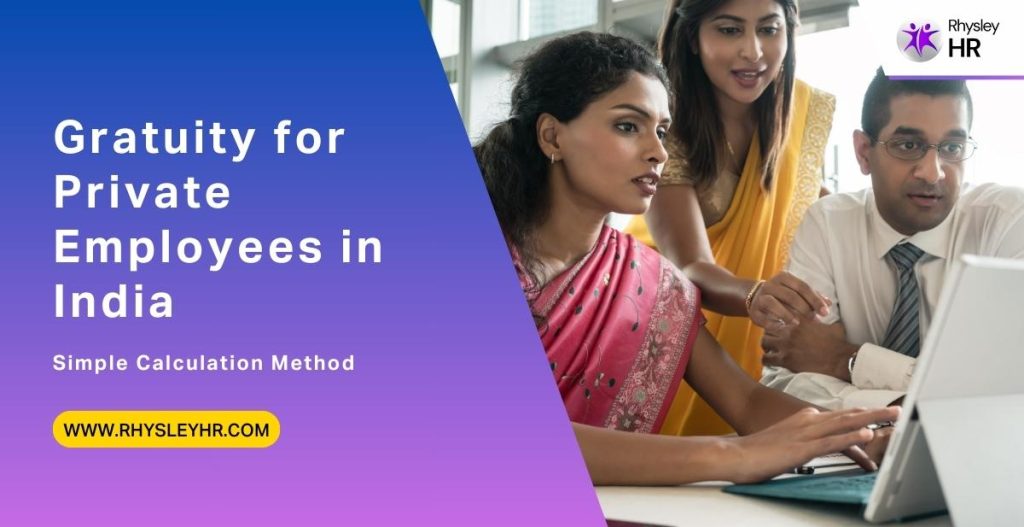Explore all premium features with a 1-Year Free Trial. Schedule your demo NOW!

Gratuity for Private Employees in India: Simple Calculation Method
Gratuity is a payment made to an employee by the employer after a certain period of continuous service. This amount acts like a thank-you for the employee’s loyalty and contribution. In India, the Payment of Gratuity Act, 1972 defines the rules for gratuity, and private companies that meet certain conditions must follow this law.
Who is Eligible for Gratuity in a Private Company in India?
An employee becomes eligible to get gratuity after completing five years of continuous service in the same organization. This applies to both full-time and contractual employees, as long as the contract is not short-term and the person works like a regular staff member.
There are a few exceptions. If an employee dies or suffers a disability due to accident or illness, gratuity becomes payable even before completing five years. Also, once a company has ten or more employees on any single day in the last 12 months, the gratuity rules apply.
How to Calculate Gratuity for Private Employees in India
Gratuity is calculated using a fixed formula. The method is simple and applies mostly to employees who are covered under the Payment of Gratuity Act.
The formula is: Gratuity = (15 × Last Drawn Salary × Number of Years of Service) / 26
- 15: This is the number of days’ salary counted for every completed year of service.
- Last Drawn Salary: Basic salary + Dearness Allowance (DA), not including bonuses or HRA.
- 26: Number of working days in a month (excluding Sundays).
For example, if the last drawn salary is ₹30,000 and the employee has completed 7 years:
Gratuity = (15 × 30,000 × 7) / 26 = ₹1,21,154
The salary gets divided by 26 instead of 30 to account for actual working days.
Gratuity Example for Private Employees in India
Suppose an employee worked for 6 years and 8 months in a company. The last drawn monthly salary was ₹40,000 (basic + DA). Here’s how it’s calculated:
- Since the service exceeds 6 years and 6 months, round it to 7 years.
- Use the formula: Gratuity = (15 × 40,000 × 7) / 26 = ₹1,61,538
If the employee worked only 6 years and 5 months, it would be rounded to 6 years.
This method helps employees predict how much they are eligible to receive after resignation or retirement.
What Are the Latest Gratuity Rules for Private Sector Employees in 2025?
The core law remains under the Payment of Gratuity Act, 1972. Over the years, updates have changed how some parts are applied. With the implementation of the new labor codes expected to be active, the definition of wages may change. This could affect the final gratuity amount.
Under the new rules, if more allowances are added into the salary for gratuity calculation, the payable amount might go up. The tax-free limit also remains ₹20 lakh for now.
Companies are expected to follow any updates made by the Ministry of Labour. Any changes that impact private employees will come into effect once these codes are enforced officially.
Read More : What is payroll software
Is Gratuity Mandatory for Private Companies in India?
Gratuity becomes a legal obligation when a company employs ten or more people on any day in the past year. Once the law applies, the company must offer gratuity to all eligible employees. Even if the number of staff drops below ten later, the rule still continues to apply.
Failing to pay gratuity as per the law can lead to legal penalties, including fines or even jail time for the employer. This makes gratuity not just a financial benefit, but a statutory right for eligible employees.
Is Gratuity Taxable for Private Employees in India?
Gratuity is partly tax-free for employees working in the private sector. As per the Income Tax Act, the limit for tax exemption on gratuity is ₹20 lakh over a lifetime. If the gratuity amount is higher than this, the extra part becomes taxable.
If the employer is not covered under the Gratuity Act, a different method is used to calculate the tax-free part, but the ₹20 lakh cap still applies. Employees are advised to keep track of their past gratuity amounts received from other employers to stay within the limit.
Frequently Asked Questions
Q1. How much gratuity will I get after 5 years in a private company?
Answer. If an employee completes exactly 5 years and the last drawn salary is ₹25,000, the formula gives — (15 × 25,000 × 5) / 26 = ₹72,115
Q2. Can gratuity be paid before 5 years?
Answr. Only in cases of death or permanent disability. Otherwise, five years of continuous service is required.
Q3. Does gratuity apply after resignation?
Answer. Yes, as long as the person completed 5 years of service. The reason for leaving doesn’t affect eligibility.
Q4. Is there a limit to the gratuity amount?
Answer. Under law, the maximum amount is ₹20 lakh. Beyond that, it becomes taxable.